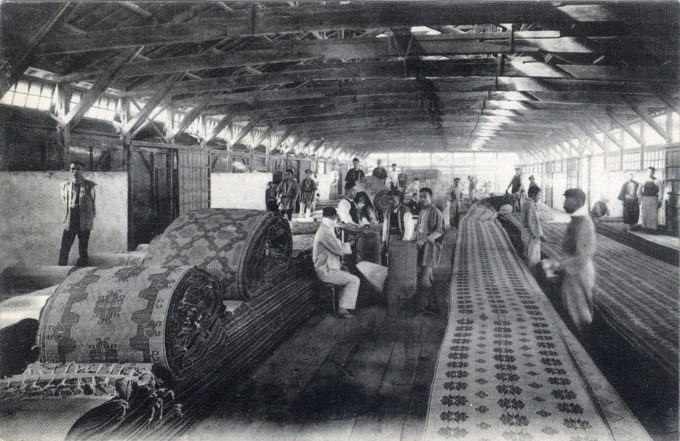“British trade with Japan is said to be affected by the comparative nearness of the United States to this market which gives [the U.S.] great advantages, particularly in regard to transport. Japanese competition is greatly increasing, and this is aided not only by the extraordinary low wages which are paid in Japan, which are not one-sixth of British wages, but also by the organisation of the Japanese industry, which is particularly favourable to the production of cheap goods in conditions hardly distinguished from what would be regarded as sweating in Great Britain.
“Japanese competition extends to rugs, carpets, mats, carpet squares, etc. Instances are given of the British importation of rugs from Japan at 13d per square foot; such rugs, it is said, would cost the British manufacturers 4d in labour alone.
“Cheap rugs, mats, carpets and Axminsters [machine-woven patterned carpet] are sold in the United Kingdom below British cost. The rugs imported from Japan are sold in large quantities by auction, mostly at the London Docks.”
– Report of the Tariff Commission (The Textile Trades), Published for the Tariff Commission by P.S. King & Sons, London, 1905

Rug and carpet factory, c. 1920, manufacturing product for export. While fabricated rugs and carpet were common floor coverings in royal Indian and imperial Chinese courts, the Japanese commoner had relied more on traditional straw- and reed-woven mats (e.g., tatami) to provide insulation, comfort and decoration. It was not until Meiji-era Western modernization that rugs and carpeting began to be used commercially as a floor covering in offices or purchased by aristocrats for their domiciles/ But, much of the manufactured output was sold for export. The postwar economic boom brought about a much greater domestic demand for rugs and carpeting.
See also:
Japanese Lanterns (Chochin).
Japanese kite makers, c. 1960.
“I sat in the dim interior of a traditional wooden townhouse as rugs were unrolled before me one after another. The smell of age wafted upward from them, captivating me with the sensation of having suddenly traveled through time to a distant land. This was my introduction to Ako dantsu [cotton carpet] rugs.
“I [admired] one with a bold zigzag pattern of swords and a gradation of blues reminiscent of sky and sea, set against a white background, feeling as if I were in an oasis city on the Silk Road. I suddenly recalled the Hayao Miyazaki animated film Nausica of the Valley of the Wind, whose fantasy-world setting is said to be based on central Asia.
“‘This design is called ‘Amiriken’. It depicts a sword that slays evil and a net that captures happiness, and it is one of the most well-known Ako rug designs,’ explained Rie Sakagami. A weaver herself, she also repairs and sells old rugs at her studio, Ako Dantsu Mutsuki … I gazed down at the rugs as curiously as someone from an earlier age seeing an imported carpet for the first time. How, I wondered, had these exotic floor coverings with their unique designs emerged here in Japan, where tatami and other types of flooring were traditionally left bare?
“Together with Sakai dantsu rugs from Osaka and Nabeshima dantsu rugs from Saga, Ako dantsu rugs number among Japan’s ‘big three’ rug styles (dantsu means ‘carpet,’ but these are often much smaller than that term would suggest). Woven in the city of Ako in Hyogo Prefecture, these rugs reached their peak of popularity between the Meiji and early Showa periods. They are made from cotton, as opposed to the more typical wool or silk.
“Prized by tea masters and other members of the Kyoto elite for their elaborate craftsmanship and colorful patterns, they were brought out for special occasions such as tea ceremonies and the annual Gion Matsuri festivities. They were also used in the imperial train that carried the emperor and empress during the Meiji period, a fact that enhanced their reputation and fame.
“At the height of their production in 1912, the six workshops in Ako wove about 5,800 square meters of product, granting the rugs status as Ako’s signature handicraft.”
– “The Mysterious Magnetism of Ako Dantsu Rugs”, by Chisa Sato, Subsequence.tv, 2022

